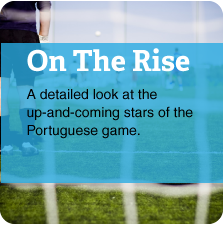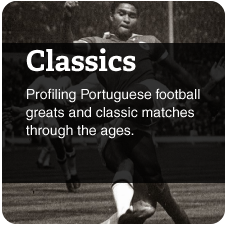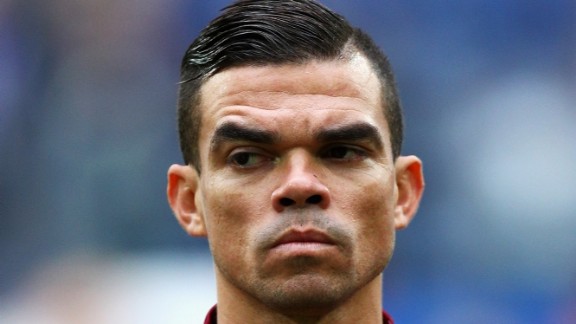 The burden of defence
The burden of defence
Welcome back for Part 2 of our series investigating the quality of Portugal’s World Cup dreams. Having examined Portugal’s goalkeeper, Rui Patricio, evaluating his skillset against World Cup-winning keepers and contemporaries alike, Portugal fans have every reason to be confident ahead of the World Cup…. so far.
As I relish the good fortune of Portugal’s goalkeeping situation, the ambiance surrounding the defence as a whole is less than inspiring.
“But we still have Pepe….” Well, yes, and the old Portuguese warhorse is still playing reasonably well for Besiktas this season. Based on their defensive performance metric, Pepe’s score is good for fifth-best in Champions League play according to Squawka, not bad for a soon-to-be 35 yr old.
But it is too infrequent that Portuguese football supporters actually consider how our individual players measure up to those of the very national teams we will contest in major tournaments. It is one thing to evaluate the merit of Pepe or Fonte with respect to younger Portuguese options such as Ricardo Ferreira or Edgar Ié. It is quite another to grade their talent with respect to Mats Hummels, Sergio Ramos, or Marquinhos, to name a few.
Alas, I have done too much statistical research to rationalize avoiding the conversation we must now have. Because in the end, while my heart wants so desperately for Portugal’s talented midfield to pacify my collective fears, the harsh truth is that most teams never go further than their defence can carry them at a major tournament.
Even the great 2002 Brazil squad that struck 18 goals only conceded four in seven matches, title winning form in its own right. The last three World Cup winners, Germany, Spain, and Italy, allowed four, two, and two goals in seven matches, respectively. Consider also that Germany scored twice as many goals as Spain at the 2010 World Cup yet finished third. That same tournament, Holland, Uruguay, Argentina, and Brazil all outscored Spain. But Spain conceded just two goals. Of course World Cup champions often finish top scorers as well, but it is an inescapable truth that teams who concentrate their tactics on shutting down the opposition usually outperform those that try to overwhelm their opponent with attacking ingenuity.
Certainly worked for Portugal at Euro 2016.
Given Portugal’s defensive solidarity at the Euros, one might feel more confident about Portugal’s chances to win it all next summer. But I have to be realistic and confess that the 18 months since the glorious summer of ‘16 have not animated my belief in our defence. Conversely, Portugal’s World Cup qualification at least partially disguised our issues because the quality of opposition was so poor.
For me, the Confederations Cup was the more significant indicator of how our defence might perform at this summer’s World Cup. Surrendering three goals in two matches against Mexico was particularly worrisome, especially the manner in which they were conceded. Even the semifinal against Chile that required penalties to settle probably should have ended differently as Chile squandered many presentable opportunities. That same Chile squad failed to even qualify for the World Cup.
One might argue Portugal allowed only 17 shots on target while preserving three clean sheets in five matches of that very same tournament, and shut out Hungary and Switzerland even more recently with rigorous defensive application. But for me there may be a hard reality lurking just beyond our ability to perceive it.
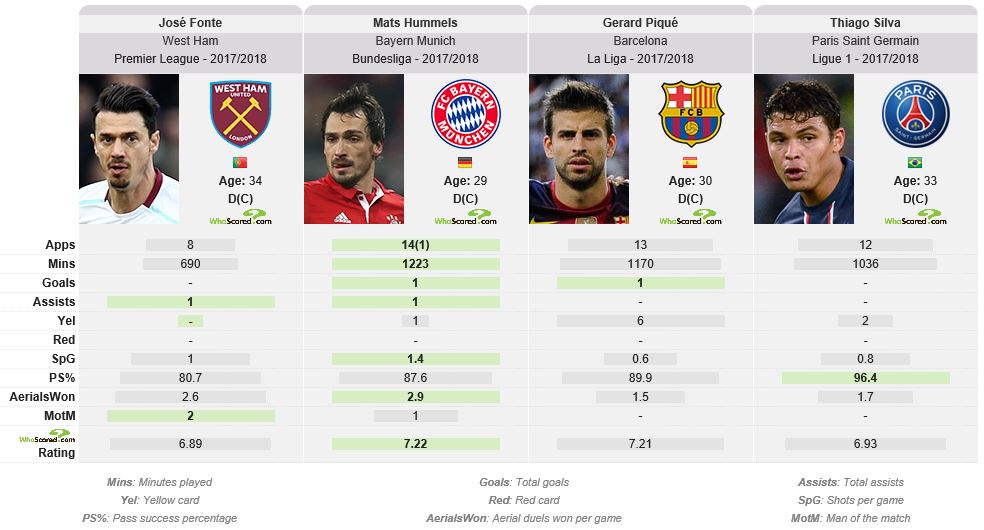
The reality that this Portugal squad’s defensive lifespan may have advanced just beyond the ideal balance between experience and youth, especially at centreback.
Having held down a starting berth at Real Madrid for almost a decade at his peak, Pepe should be considered a legend of the game and still possesses the quality for one last tournament. I honestly cannot say the same for his partner, whose identity is very much unresolved at this stage. Hearts in mouths, we hope Jose Fonte recovers well from an ankle injury, no guarantees at his age. Luís Neto is in-and-out of Fenerbahce’s starting XI, and while Paulo Oliveira and Edgar Ié continue to play reasonably well for their clubs, they simply do not have the requisite experience to complement what I would consider a World Cup-winning back four.
Bruno Alves is 36 years old and playing against competition in Scotland that pales in comparison to what Portugal will encounter at the World Cup. Pedro Mendes is only 27 and has made a compelling case at Montpelier in Ligue 1, but has yet to even be selected for a Portugal squad. Rúben Semedo and Daniel Carriço have fallen off the radar entirely due to loss of form and injury. Granted it was his first ever cap, but Ricardo Ferreira was awful in a friendly against a very average United States squad in November, and has just recently sustained a serious knee injury.
The bottom line? There is no complement to Pepe that is not a liability to some extent.
There are positive counterpoints despite Portugal’s centreback duo appearing less than optimal after investigating the relevant data and comparing our individual defenders to those in previous World Cup-winning squads.
First, Santos’ tactical blueprint does shield our defence’s weak center. Defence is still a team activity, not just a job for the four players composing the backline, and it is no secret our squad has a fundamentally pragmatic outlook and will recede into a defensive posture when required. Second, Portugal have greater versatility at fullback, especially on the right. With the margins of the pitch more secure, the center of Portugal’s defence can concentrate their efforts on tracking diagonal runs made by opposing No9s, or so it goes in theory.
In the interest of brevity, I won’t go into much detail on our fullbacks except to provide a brief statistical run-down based on assimilated data from WhoScored.com and Squawka. Fábio Coentrão is our top performing left back while Ricardo Pereira is statistically stronger than his nearest competitors, Cédric, João Cancelo, and Nélson Semedo (see graphic below).
Regrettably, the news that nobody wants to hear is true: aside from Ricardo Pereira, none of our fullbacks are in exceptional, world-beating form at the moment. When I ran statistical comparisons between Portuguese fullbacks and others such as Marcelo, Jordi Alba, Joshua Kimmich, etc, the results were very one-sided for all the wrong reasons.
Nevertheless, club form alone fails to tell the whole story as to how an individual player might perform on the international stage. While it is undeniable the very best players in football feature consistently for their clubs and statistically dominate their rivals, there are cases in which average club players made huge contributions for their national team.
Fabio Grosso played for lowly Palermo in Serie A prior to the 2006 World Cup, making such a critical contribution from left back that he earned a move to Inter Milan after the tournament. Even so, he failed to build on his World Cup performances, was sold to Lyon after just one season, and only made around 100 appearances for Lyon and then Juventus over the remaining five years of his career. In a similar manner albeit with less impact, players like Hélder Postiga and Silvestre Varela had their moments for Portugal despite very average club careers.
All things considered, there is clearly some risk in predicting a player’s national team potential based only on club form. Still, comparing our pool of centrebacks with those from past tournament champions as well as those from other national teams of the present, I cannot escape the nagging concern we just do not possess the optimal blend of raw talent, experience, and form. Too old, too young, not enough caps, not enough club playing time, not fit….no matter the vantage point for this debate, the critical determinants for success just aren’t there.
When I ran Squawka’s statistical ranking of the top defenders in Europe’s Top Five Leagues plus Portugal’s domestic league, none of Portugal’s defenders scored high enough to even make the top 50. Brazil, Germany, Spain, and France were all represented.
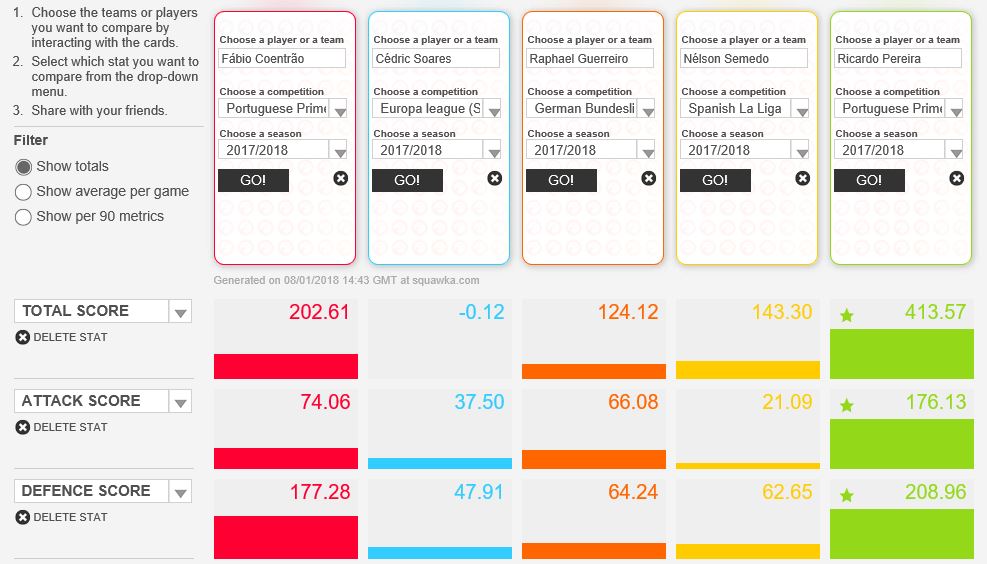
Once again I will point out that Portugal’s first World Cup match against Spain is of crucial significance for its role in demystifying this squad’s potential. It is fair to say we will have learned much about the squad’s ability to withstand threat from an organized, skillful attacking unit right from the onset.
From there, who knows? I leave the reader with one final perspective of Portugal’s defensive concerns. Imagine our best-case-scenario centreback duo against Brazil or Argentina. What are the odds that a match-up against Messi and Aguero or Neymar and Gabriel Jesus ends up in their favor?
Let me be honest. I’m having a hard time with that one, though it is true that most defences would have their hands full against either one of those strike partnerships. My final verdict on our defence? It hurts me to say that I find them wanting. For Portugal’s World Cup dream to become reality, our centrebacks in particular will need to tap into a reservoir of good form they simply have not discovered at club level this season, at least not yet.
Otherwise, Portugal’s defensive strength will need to be tactically derived, i.e., a structural defence in which the whole is greater than the sum of its individual parts, credit Aristotle for that philosophical divination. Among other options, that might mean compressing our midfield quartet to deny passing lanes, or utilizing a direct, attacking threat to keep the opposition on the back foot. Knowing Santos, I wouldn’t bet on the latter.
In Part 3 we will consider Portugal’s midfield and offensive talent and whether Fernando Santos will be able to ease our defensive burden without sacrificing attacking effectiveness.
Força Seleção.
by Nathan Motz


